Gold Note Donatello Gold Moving Coil Phono Cartridge by Greg Simmons

That’s a Lot of Gold Note
 The subject of this review, the Donatello Gold moving coil phono cartridge is the third Gold Note pickup I’ve had the pleasure of listening to this year. Before that I’d also reviewed Gold Note’s then flagship Mediterraneo turntable and B-7 ceramic tonearm, which was an easy combination to recommend. That’s a lot of ink spilled on one manufacturer in a single year, but I haven’t found a clinker yet, so I’ve kept on with it. Gold Note’s equipment sounds pretty darned good.
The subject of this review, the Donatello Gold moving coil phono cartridge is the third Gold Note pickup I’ve had the pleasure of listening to this year. Before that I’d also reviewed Gold Note’s then flagship Mediterraneo turntable and B-7 ceramic tonearm, which was an easy combination to recommend. That’s a lot of ink spilled on one manufacturer in a single year, but I haven’t found a clinker yet, so I’ve kept on with it. Gold Note’s equipment sounds pretty darned good.
Beautiful Music
I’m an, ‘As-You-Like-It’ audiophile, a term that may have been back-handedly coined by the late Harry Pearson. As I look out at the audio landscape, and consider the equipment I’ve listened to over recent years, I’ve concluded that while specifications are certainly important benchmarks the highest quality I care about in any equipment is that the reproduced music makes my ears happy. Two components can sound radically different and still be musically satisfying, and which of those components offers better “accuracy” may be completely irrelevant in determining which one you think makes your music sounds best. I once wrote that if I could recreate the visceral image of John Coltrane blowing right in front of me, what the hell did I care whether the system could actually reveal the shape of room he was playing in? That is still my opinion years latter.
 I only mention this because having reviewed so many products from Gold Note this year, I feel as though I’ve gained at least a little bit of perspective on their design emphasis. My general impression of their equipment – to varying degrees, partially based on the price of each product – is that their gear is capable of offering lots of hi-fi goodies like fine detail retrieval, soundstage depth, and good extension top and bottom, but similar to equipment from other Italian companies I’ve listened to recently, the Gold Note gear sounds as though someone spent a great deal of time making sure that their products are first and foremost pleasurable to listen to the old fashioned way, by ear. This is as it aught to be.
I only mention this because having reviewed so many products from Gold Note this year, I feel as though I’ve gained at least a little bit of perspective on their design emphasis. My general impression of their equipment – to varying degrees, partially based on the price of each product – is that their gear is capable of offering lots of hi-fi goodies like fine detail retrieval, soundstage depth, and good extension top and bottom, but similar to equipment from other Italian companies I’ve listened to recently, the Gold Note gear sounds as though someone spent a great deal of time making sure that their products are first and foremost pleasurable to listen to the old fashioned way, by ear. This is as it aught to be.
As it turns out, I wasn’t just imagining that. In an email, Gold Note Founder Maurizio Aterini confirmed my impression: “When we have to decide about technical details or sound quality, we certainly look more towards getting the best audio performance even though sometimes they do not exactly match the super high-tech specifications.” I’m with Maurizio on this one. All of the Gold Note products I’ve listened to have been very musical (as opposed to clinical) and the Donatello Gold is no exception. I’ve really come to appreciate the way Gold Note voices their analog products.
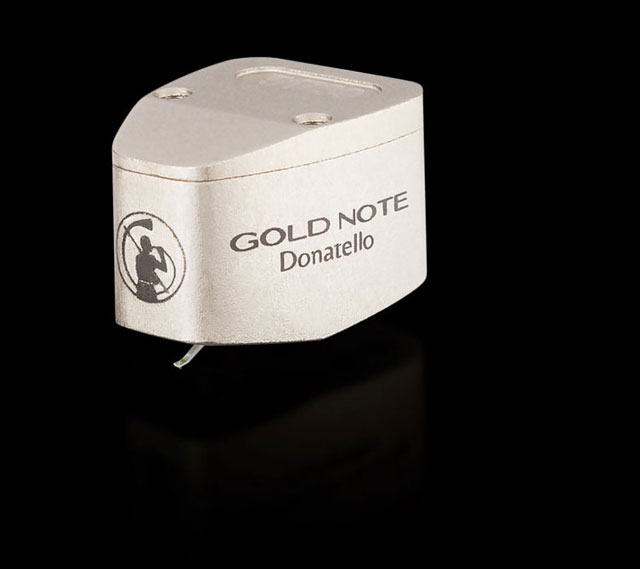
The Golden Nugget
The Donatello Gold – which is really more of a pale Champagne color – is the top of what I’d describe as Gold Note’s relatively affordable offerings. At $1,199.00 it’s still a phono pickup that’s within reach for many folks. By comparison, the next step up Gold Note’s cartridge ladder – the Machiavelli moving coil – comes with an almost three-fold price increase.
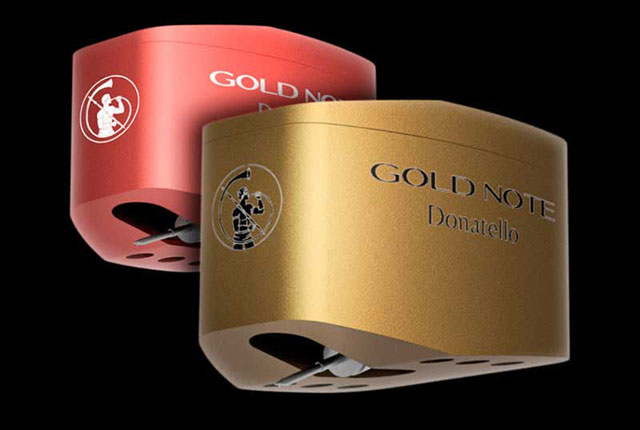 Physically, the Donatello Gold looks almost identical to the Red (photo right), except for the color, and contains many similar parts – the aluminum cantilever, Samarian-cobalt magnets – but the Gold comes with a more sophisticated super-fine-line stylus and different coil windings. Gold Note designs and manufactures their cartridges in house in Italy, but relies on the Japanese companies Namicki/Adamant or Ogura for stylus, cantilevers, and cross bars, all made or modified to their requirements.
Physically, the Donatello Gold looks almost identical to the Red (photo right), except for the color, and contains many similar parts – the aluminum cantilever, Samarian-cobalt magnets – but the Gold comes with a more sophisticated super-fine-line stylus and different coil windings. Gold Note designs and manufactures their cartridges in house in Italy, but relies on the Japanese companies Namicki/Adamant or Ogura for stylus, cantilevers, and cross bars, all made or modified to their requirements.
The DG also features a set of relatively mainstream operating specifications. Output is .5mV, slightly lower than my Lyra Delos but by also slightly higher than my pair of Audio-Technica moving coils. Gold Note describes the Donatello Gold as “low-output”, but .5mV is pretty conventional moving coil territory. Truly low-output cartridges these days from Lyra, Ortofon, and even Gold Note’s own flagship, the Tuscany Gold, are producing genuinely low 0.1 to 0.25mV output, and a few others go even lower than that. Dynamic compliance is an all-purpose 12×10-6cm/dme. Recommended tracking force range is 1.8 to 2.1 grams.
Frequency response is a reasonably broad 10Hz to 40kHz, while loading is recommended at a comparably high-ish 470Ω. The closest to that figure attainable in my phono stage is 500Ω, so I went with that. I did try the DG at lower settings down to 100Ω and found that as the loading decreased the overall sound softened in back-to-back listening. Otherwise, assuming a phono stage with variable load settings, the Donatello Gold should be a fairly easy to integrate with most systems.
Setup
 When I reviewed the Donatello Red a few months ago I noted that it had a very small, light body weighing a diminutive 7 grams. As a result of the smaller – read shorter – body, I had difficulty getting the cartridge far enough forward in the headshell slots to get it perfectly aligned on the cross-hairs of my Dr. Feikert’s protractor. The stylus alighted about 1 millimeter behind the Baerwald mark. However, it did achieve perfectly parallel alignment over the longitudinal lines. I had no choice but to run it that way, surrendering that last millimeter.
When I reviewed the Donatello Red a few months ago I noted that it had a very small, light body weighing a diminutive 7 grams. As a result of the smaller – read shorter – body, I had difficulty getting the cartridge far enough forward in the headshell slots to get it perfectly aligned on the cross-hairs of my Dr. Feikert’s protractor. The stylus alighted about 1 millimeter behind the Baerwald mark. However, it did achieve perfectly parallel alignment over the longitudinal lines. I had no choice but to run it that way, surrendering that last millimeter.
Setting up the Donatello Gold required the exact same compromise, though in the process of messing around with it I did discover that my arm is mounted at 215mm instead of 214mm, which accounts for that one wayward millimeter to the Baerwald mark, but comes nowhere close to the Lofgren mark, which is what I typically prefer to use. In the end this has more to do with the arm than the cartridge, I think.
The cartridge has a reasonably wide body with full sides allowing good purchase for making fine alignment adjustments without endangering the stylus, which is tucked well underneath and out of the way. VTA, VTF and Azimuth were simple enough to align through the arm and headshell. I played with it for a few days, tweaking here and there, but other than the missing millimeter it was an easy cartridge to work with.
The last bit of setup I did – about a week after I’d installed the cartridge, simply because I’d forgotten to do it initially – was to set the anti-skate. I use the imprecise though effective method of lowering the needle onto a blank record side – in this case side six of the recent Sam Records reissue of Nathan Davis’ Live in Paris (Sam Records SR20/2) – then dialing in the anti-skate until the arm almost stops moving towards the center of the record, then verifying the action at a few points across the arc. With the Gold, the anti-skate wound up dialed to 1.75, slightly lower than the 1.85g tracking force I was using. There’s some debate about how much anti-skate to dial in, or even whether you need it at all – VPI for example does not provide any mechanism to set anti-skate on any of it’s tables – but I find it to be an important step. With my Jelco arm I find that using it reduces surface noise. In the case of the Donatello Gold it had that exact effect as well as smoothing out the treble, and enhancing some low-level details and spacial cues.
A Little Break In
Straight out of the box, the Donatello Gold was a bit burley, which was not surprising or cause for concern. A break in period is something I’ve come to expect from most brand new pickups. After just a day or so worth of spinning records a significant portion of those undesirable effects subsided and the cartridge became smoother, more detailed, and more authoritative. After a week things really started opening up with sound becoming more dimensional and the bass fuller, deeper and more defined. At that point the overall quality exceeded that of the Donatello Red I’d reviewed just a few months earlier. I played it uncritically for another few weeks during which the sound became more relaxed and organic.
Ascoltiamo La Musica
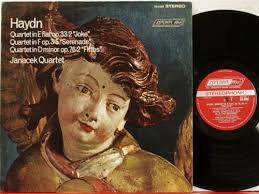 First, just to get this out of the way, on clean vinyl that hasn’t been abused the Donatello Gold is very quiet in the groove, always a great baseline for any cartridge.
First, just to get this out of the way, on clean vinyl that hasn’t been abused the Donatello Gold is very quiet in the groove, always a great baseline for any cartridge.
I started my serious listening with a London Records recording of the Janacek Quartet playing a trio of Franz Joseph Haydn’s named quartets: E flat op. 33/2 “Joke”; F op.3/5 “Serenade; and D minor op.76/2 “Fifths” (London CS6385 Stereo). This is a crisp, transparent production that captures a lot string and case resonances with plenty of aggressive transients in the treble. Sometimes the fiddles sound as though they are tearing the air. These are the kind of effects that can devolve into the equivalent of nails on a chalkboard if not handled with care. A lessor cartridge might leave those violins sounding hard and strident, for example. The Gold performs a great balancing act, retaining the recording’s bite without losing control and sending me running for earplugs. With the treble well managed, the rest of the music simply flowed naturally. This record is a lovely performance, by the way, and the Donatello Gold really did it justice.
 Another record where the Gold really delivered the goods was a stereo pressing of Gerry Mulligan’s The Concert Jazz Band on Verve (Verve MG VS-68388, 1960). This record is all about the arrangements, midrange grip and commanding woven textures: Mulligan’s baritone saxophone surrounded by significant reed and horn section, but with a definite emphasis on massed reeds. With up to thirteen musicians, the band is a little larger than the arrangements for the nonet that became Miles Davis’ Birth of the Cool – which Mulligan also arranged – but the effect is strikingly similar. When they’re really cooking, the reeds have positively seismic vibrato, creating a powerful, air-moving, physical effect. In some places the application is derivative of something like Woody Herman’s release of Jimmy Giuffre’s Four Brothers, in others it’s got Duke Ellington written all over it – both good things as far as I’m concerned – and all of it is anchored in the middle by Mulligan’s big sax. The hot numbers just fill the room with wall-to-wall saxophones, a very exciting performance to listen to. It must have been a blast to hear this unit live.
Another record where the Gold really delivered the goods was a stereo pressing of Gerry Mulligan’s The Concert Jazz Band on Verve (Verve MG VS-68388, 1960). This record is all about the arrangements, midrange grip and commanding woven textures: Mulligan’s baritone saxophone surrounded by significant reed and horn section, but with a definite emphasis on massed reeds. With up to thirteen musicians, the band is a little larger than the arrangements for the nonet that became Miles Davis’ Birth of the Cool – which Mulligan also arranged – but the effect is strikingly similar. When they’re really cooking, the reeds have positively seismic vibrato, creating a powerful, air-moving, physical effect. In some places the application is derivative of something like Woody Herman’s release of Jimmy Giuffre’s Four Brothers, in others it’s got Duke Ellington written all over it – both good things as far as I’m concerned – and all of it is anchored in the middle by Mulligan’s big sax. The hot numbers just fill the room with wall-to-wall saxophones, a very exciting performance to listen to. It must have been a blast to hear this unit live.
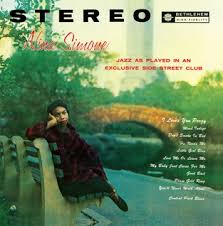 Finally, just to throw in some female vocals I played Nina Simone’s debut album, Jazz As Played In An Exclusive Side Street Club in stereo (Analog Productions, Bethlehem Records BS-6028). I’ll state right here that while the capture of the instruments on this record is excellent, the stereo mix is just weird. The piano bass and drums are hard-panned to one side while the piano player – Ms. Simone – is hard panned to the opposite side, nowhere near the instrument she’s supposedly playing. I get that they were trying to isolate the vocals, but the effect is just … well, like I said … weird. Even a really good cartridge like the Donatello Gold can’t gloss over that mess. On the other hand, the capture of the voice, as well as the supporting instruments is very well done. The piano has great clarity, case resonance and weight, even stuffed in a corner as it is. Ms. Simone’s smoky alto is deep with physical timbres that sound as though they’re emanating from a living, breathing person, which of course they were. Plus, Ms. Simone always sang with her emotions on her sleeve, offering a limbic connection to the performance. The music is first-rate. We’ll just agree to ignore the strange panning. You’ll hit the mono switch if you know what’s good for you.
Finally, just to throw in some female vocals I played Nina Simone’s debut album, Jazz As Played In An Exclusive Side Street Club in stereo (Analog Productions, Bethlehem Records BS-6028). I’ll state right here that while the capture of the instruments on this record is excellent, the stereo mix is just weird. The piano bass and drums are hard-panned to one side while the piano player – Ms. Simone – is hard panned to the opposite side, nowhere near the instrument she’s supposedly playing. I get that they were trying to isolate the vocals, but the effect is just … well, like I said … weird. Even a really good cartridge like the Donatello Gold can’t gloss over that mess. On the other hand, the capture of the voice, as well as the supporting instruments is very well done. The piano has great clarity, case resonance and weight, even stuffed in a corner as it is. Ms. Simone’s smoky alto is deep with physical timbres that sound as though they’re emanating from a living, breathing person, which of course they were. Plus, Ms. Simone always sang with her emotions on her sleeve, offering a limbic connection to the performance. The music is first-rate. We’ll just agree to ignore the strange panning. You’ll hit the mono switch if you know what’s good for you.
“Reference” Sounds So Pretentious
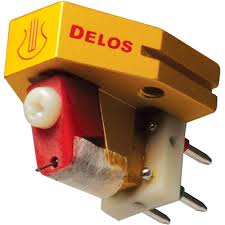 The Donatello Gold has a lot going for it, but I wanted to do a little comparison with my reference Lyra Delos (I’ve never used the word “reference” to describe anything in my system and I think it sounds silly, but everyone knows what it means, so I’ll go with it). For starters, the Delos costs almost twice as much as the Gold, so it’s not quite an apples-to-apples match up, but the Gold has been touted as something of a giant slayer, so it seemed like a worthwhile comparison. The Gold has very good resolution and clarity, but not quite as good as the Lyra, which offers a wonderfully liquid, grain-free presentation. The Delos also offers a slightly larger sound stage, deeper, punchier bass, and a little more illumination of the musicians, where the Gold is a little darker sounding. Going the other way, the Gold seemed slightly faster on some records, and in a few circumstances overall dynamic power was a shade better with a little more jump factor. The gold also had a slight advantage on those air-ripping textures I mentioned earlier, and is also warmer, where the Lyra is definitely a more neutral observer. The Gold also shows off a bit more tone color saturation. A lot of these differences will come down to which qualities the listener values most. In my system, the Lyra’s more neutrality, details and accuracy works better with the decidedly warmer signal processing of the twenty-seven vacuum tubes downstream, at least to my ear, but the Donatello Gold made a good case for itself and easily earns its audiophile credentials.
The Donatello Gold has a lot going for it, but I wanted to do a little comparison with my reference Lyra Delos (I’ve never used the word “reference” to describe anything in my system and I think it sounds silly, but everyone knows what it means, so I’ll go with it). For starters, the Delos costs almost twice as much as the Gold, so it’s not quite an apples-to-apples match up, but the Gold has been touted as something of a giant slayer, so it seemed like a worthwhile comparison. The Gold has very good resolution and clarity, but not quite as good as the Lyra, which offers a wonderfully liquid, grain-free presentation. The Delos also offers a slightly larger sound stage, deeper, punchier bass, and a little more illumination of the musicians, where the Gold is a little darker sounding. Going the other way, the Gold seemed slightly faster on some records, and in a few circumstances overall dynamic power was a shade better with a little more jump factor. The gold also had a slight advantage on those air-ripping textures I mentioned earlier, and is also warmer, where the Lyra is definitely a more neutral observer. The Gold also shows off a bit more tone color saturation. A lot of these differences will come down to which qualities the listener values most. In my system, the Lyra’s more neutrality, details and accuracy works better with the decidedly warmer signal processing of the twenty-seven vacuum tubes downstream, at least to my ear, but the Donatello Gold made a good case for itself and easily earns its audiophile credentials.
Wrap It Up
Twelve-hundred bucks for a phono cartridge is still a sizeable investment for many folks, but Gold Note’s Donatello Gold moving coil offers an enormous level of performance and competence for the price. In my system it was always lively, supremely musical, and capable of forging a deep connection with whatever album I was listening to. It also checked a lot of hi-fi boxes: good detail, resolution, dynamic punch, and sonic weight, all the qualities people should be looking for in a good moving coil phono cartridge. Most importantly, the voicing of this cartridge – leaning towards musical satisfaction over analytics – did justice to almost every record I played. This is one well turned out phono cartridge. If you’re shopping in this price range, or even a little higher, do yourself a favor and seek out the Donatello Gold for an audition. It’s an excellent cartridge.
A Literary and Musical Post-Script
As I write this, I’m in the process of re-reading D.G. Kelley’s exhaustively researched and exceptionally good biography, Thelonious Monk: The Life and Times of an American Original. I heartily recommend this book to anyone who wants to truly understand one of the twentieth century’s most enigmatic and misunderstood artists.
 Among the great stories in this book is Monk’s personal discovery, performance, and recording of “Kōjō no Tsuki” which roughly translates to ‘The Moon over the Ruined Castle’, which Columbia Records needlessly renamed “Japanese Folk Song” for 1967’s Straight, No Chaser album. The music was not, in fact, a folk song at all. It was originally written by Rentarō Taki in 1901 for a student contest, and was eventually included in Japanese music textbooks for elementary students, becoming nationally ubiquitous. By the 1960s, virtually everyone in Japan knew the song.
Among the great stories in this book is Monk’s personal discovery, performance, and recording of “Kōjō no Tsuki” which roughly translates to ‘The Moon over the Ruined Castle’, which Columbia Records needlessly renamed “Japanese Folk Song” for 1967’s Straight, No Chaser album. The music was not, in fact, a folk song at all. It was originally written by Rentarō Taki in 1901 for a student contest, and was eventually included in Japanese music textbooks for elementary students, becoming nationally ubiquitous. By the 1960s, virtually everyone in Japan knew the song.
Thelonious heard it while touring there, put together an arrangement, and debuted it while still in country. Japanese audiences went nuts for it, helping to energize Thelonious at the end of a tour during which European critics found performances formulaic and uninspired, and where Monk himself was reportedly disengaged from his own music. The final Japanese leg of that year’s world tour proved to be highlight.
After reading that passage in the book, I naturally had to re-listen to “Kōjō no Tsuki” on a first-rate Impex reissue of Straight No Chaser from a couple of years ago (Impex, Columbia CS 9451, 1967). With the Donatello Gold installed on my turntable, Monk’s piano is big and full of color with all of the mass, volume, and over- and undertones a properly recorded piano should have. Rouse’s tenor is pushed a little forward of the piano on stage-right, still hard-panned a bit too much for my taste, though that’s certainly not the cartridge’s fault. Larry Gales’ bass goes deep and is also placed properly in front of the piano, though the engineer moves him about laterally depending on whether he’s supporting or soloing. Ben Riley’s kit spreads across the left side of the stage, as a large multi-piece instrument aught to. The sound of the Impex pressing is far superior to the original Columbia pressing, enhancing the entire performance. The Donatello Gold gave me all of the track’s best qualities: a beautiful reproduction of an important musical event, and by 1967 Monk adding any new song to his repertoire was indeed a musical event. The cartridge, paired with a first-rate pressing was exceptionally enjoyable musical experience. Nicely done!


greg simmons
Specifications
Price: $1,199.00
Type: Moving Coil, low output phono cartridge
Output: 0.5mV
Frequency Response: 10Hz – 40kHz
Impedance: 40 Ω
Suggested Load: 470Ω
Compliance: 12 x 10-6 cm/dyne
Channel Separation: >24dB
Chanel Balance: >1dB
Suggested Tracking Force: 1.8g to 2.1g
Cantilever: Aluminum
Diamond: Super fine-line elliptical
Wiring: Copper
Magnets: Samarian Cobalt
Mounting Hole to Stylus: 9mm
Weight: 7g.
Importer: Rutherford Audio – www.rutherfordaudio.com
Associated Equipment:
Analog Front End
SOTA Sapphire turntable
Rek-O-Kut T12h turntable
Technics 1200 Mk 1 turntable
Technics 1200 M3G turntable (Stock Arm)
Jelco 9” SA-750 DB toneam (SOTA)
AudioQuest (Orsonic AV 101B) 14.5g headshell
AudioQuest PT-6 tonearm (Tech-12 Mk I)
Karmadon 12” viscous damped unipivot tonearm (Rek-O-Kut)
Lyra Delos cartridge
Audio-Technica OC/9-III cartridge
Audio-Technica AT33Sa cartridge
Miyajima Spirit Mono cartridge
Dusty Digital Front End
Cambridge CXC CD transport
Cambridge 840C CD player
Amplification
Cary SLP-98P preamp w/ phono stage
Cary CAD 280 SA V12R power amplifier
Aurorasound SP-03H step-up transformer
Lyric Audio PS-10 MC/MM phono stage
Loudspeakers
Verity Audio Fidelity Encore
Cabling
AudioQuest Copperhead Interconnects
AudioQuest William Tell ZERO speaker cables
AudioQuest Water Interconnects
Zentara Reference ICs
Zentara Reference Speaker Cables
Nordost Blue Heaven ICs
Cullen power cables
AudioQuest NRG-Z3 power cables
MIT Z-Cable power cables
Accessories
AudioQuest Niagara 1200 power conditioner
Tice Box power conditioner
Nordost Sort Kones AC vibration dampers
Mapleshade Audio Rack
Stereo Times Masthead
Publisher/Founder
Clement Perry
Editor
Dave Thomas
Senior Editors
Frank Alles, Mike Girardi, Russell Lichter, Terry London, Moreno Mitchell, Paul Szabady, Bill Wells, Mike Wright, and Stephen Yan,
Current Contributors
David Abramson, Tim Barrall, Dave Allison, Ron Cook, Lewis Dardick, John Hoffman, Dan Secula, Don Shaulis, Greg Simmons, Eric Teh, Greg Voth, Richard Willie, Ed Van Winkle, Rob Dockery, Richard Doron, and Daveed Turek
Site Management Clement Perry
Ad Designer: Martin Perry







Be the first to comment on: Gold Note Donatello Gold Moving Coil Phono Cartridge by Greg Simmons